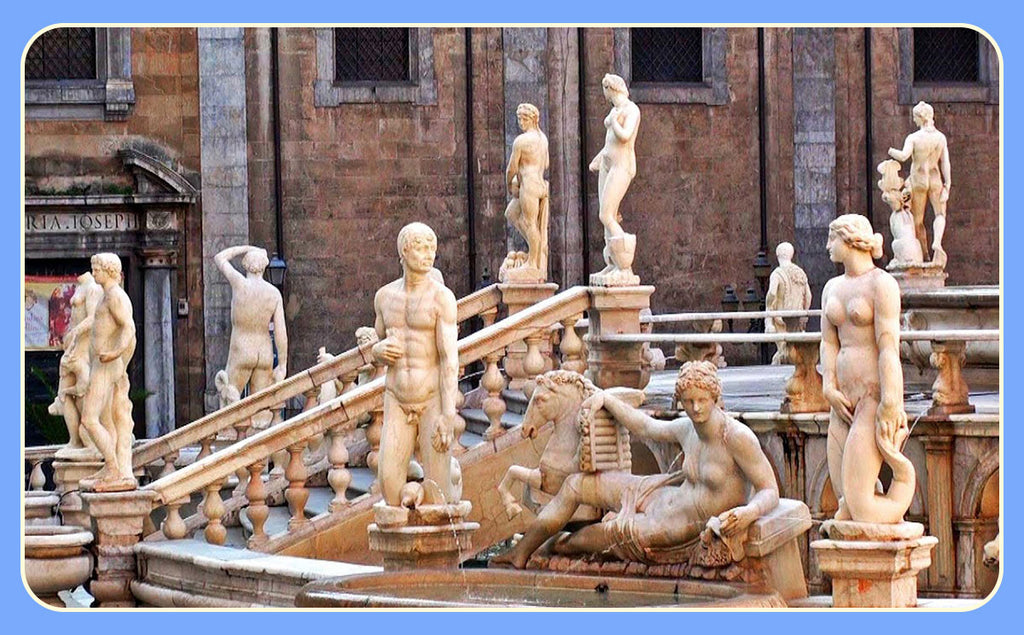
Now that things are slowly beginning to return to “normal”, we are very excited to start our tour around the Mediterranean. Discover the places that inspire us and our designs.

Our first stop is Palermo, the capital of Sicily. It’s a crumbling film set of a city with an unmissable architecture, vivid street life, and a great choice of alfresco restaurants and bars. Marked by past conquerors, each Baroque church and Norman-Romanesque facade is a reminder of prosperous eras past.
But while many of the Sicilian capital’s architectural landmarks could best be described as decaying, amid the cracks are hints of progress: like a budding contemporary art scene and forward-thinking restaurants energizing rundown neighborhoods. We are in love with this city and do as the Sicilians say, “Quannu amuri tuppulìa, ’un lu lassari ’nmenzu la via”, when love knocks, be sure to answer. Let the journey begin.
WHAT WE’VE VISITED
Cattedrale di Palermo, the gilded chapel of the Norman Kings, to marvel at the golden Byzantine mosaics.
Palazzo dei Normanni, the royal palace, whose highlight is the Palatine Chapel, covered in golden mosaics of scenes from the Bible.
Palazzo Conte Federico, a Palermo landmark and a supremely luxurious residence. The Hohenstaufen-descended count or his multi-talented wife will take you on a tour of their home (also a bed and breakfast), where you can glimpse fine decorations from around the world.

Cappella Palatina, he highest artistic expression of Latin, Byzantine, and Arabic style, with gold, mosaics and marble covering every inch of its interior.
Piazza Vigliena, whose four baroque corners mark the centre of the historic quarter, locally known as Quattro Canti. Immediately south and east is grandiose Piazza Pretoria, also known as Piazza della Vergogna, the square of shame, for the thoroughly naked statues of nymphs, tritons and leaping river gods adorning the magnificent circular fountain in front of the Palazzo Pretorio (City Hall). In the streets around are stunning 12th-century churches, Arab-Norman Chiesa Santa Maria dell’ Ammiraglio, Chiesa Capitolare di San Cataldo with its distinct faded red domes, and the baroque 16th-century Chiesa di Santa Caterina.

Palazzo Branciforte, a Renaissance-style aristocratic palace.
Orto Botanico di Palermo, a charming botanical garden to escape from the urban hustle and bustle. It’s the oldest of its kind in Europe and is one of the best academic institutions in Italy.
Palazzo Riso, a beautiful late-Baroque building whose restoration after decades of neglect resulted in a home for the Museum of Contemporary Sicilian Art.
Galleria d’Arte Moderna (GAM), which moved into a complex of interconnected structures — including a former Franciscan convent — dating to the 15th century.
Francesco Pantaleone Gallery, a white-walled contemporary gallery that presents conceptual shows from rising Italian art stars.
The three main markets, Capo, Vucciria and Ballarò offer an abundance and variety of food, and their theatrical vendors, give Palermo’s markets a distinct attitude.
WHERE WE ATE AND DRANK
Al Gelatone, a colorful gelato shop scoops dozens of artisanal variations, like watermelon granita, lemon-basil sorbetto, and toasted-almond and pistachio gelato offered Sicilian-style, in a sweet brioche bun.
Enoteca Vinoveritas, a tiny neighborhood wine shop that doubles as a low-key local hangout during aperitivo. Glasses of idiosyncratic Sicilian varietals like grillo and nero d’Avola are poured at the short wooden bar and accompanied by a generous variety of snacks.

Pasticceria Cappello, a pastry shop on a run-down street behind the palace. Don’t miss the torta setteveli, a cake native to the city featuring seven chocolately, hazelnutty layers.
Antico Caffè Spinnato, a historic cafe on a pedestrian thoroughfare. The traditional order is a crisp golden ball of rice stuffed with ragù, but the better choice here is the rich arancina con burro.
Bar Garibaldi, for a fun late-night drink. Order a Negroni at the bar, find a seat in the back amid propaganda posters and shelves of left-leaning literature, and enjoy the music and sociable atmosphere.
Antica Focacceria San Francesco, an old cafe in a cobbled backstreet specialises in fast food Sicilian-style, like arancini (fried rice balls with various gloopy fillings) or vistedde (boiled spleen in a brioche roll).
WHERE WE STAYED
La dimora del genio is a charming bed-and-breakfast hidden away on a upper floor of a residential building. Lose yourself in the uniquely decorated rooms, full of colour, character and art. It has 2 bedrooms with a shared lounge and room service for your convenience. The owner Paola is welcoming and exquisite in her recommendations.

WHEN TO GO
With summers that last from April to October and mild winters, Palermo is a year-round destination. Early spring and late summer are possibly the best for fewer visitors with warm, but not hot temperatures. Average temperatures are around 13ºC in February, 19ºC in May, 27ºC in August and 21ºC in October. The rainiest months are December, November and October.






